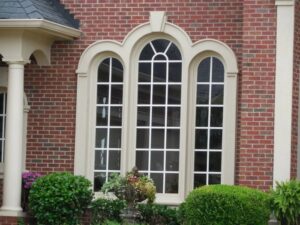
As Best energy-efficient windows 2025 takes center stage, this opening passage beckons readers into a world crafted with good knowledge, ensuring a reading experience that is both absorbing and distinctly original.
The rise of energy-efficient windows is reshaping the way we think about home improvement and sustainability. With innovative technologies making their debut in 2025, homeowners have the chance to significantly reduce energy consumption while enhancing aesthetic appeal. This overview will highlight the latest advancements, compare top brands, and discuss the key features that contribute to energy efficiency in modern windows.
Best Energy-Efficient Windows for 2025

As we move into 2025, the demand for energy-efficient windows continues to rise, driven by both environmental concerns and the desire for cost savings. The newest technologies have brought us innovative solutions that not only enhance energy efficiency but also improve aesthetics and functionality. This year, several brands have emerged as leaders in the market, showcasing cutting-edge features that contribute to sustainability and comfort in the home.Recent advancements in energy-efficient windows include technologies such as triple glazing, low-emissivity (Low-E) coatings, and gas fills like argon or krypton between panes.
These features work together to minimize heat transfer, thereby keeping homes warmer in the winter and cooler in the summer. Additionally, smart window technologies enable homeowners to adjust tinting and transparency based on weather conditions, further enhancing energy savings and comfort.
Latest Technologies in Energy-Efficient Windows
The integration of advanced technologies plays a crucial role in the performance of energy-efficient windows. Below are some of the significant innovations that are setting new standards in 2025:
- Triple Glazing: This technology involves three layers of glass, providing superior insulation compared to traditional double-glazed windows. Triple glazing significantly reduces heat loss and is particularly beneficial in colder climates.
- Low-E Coatings: Low-emissivity coatings reflect infrared light while allowing visible light to pass through. This helps to maintain indoor temperatures while reducing reliance on heating and cooling systems.
- Gas Fills: Windows filled with inert gases like argon or krypton enhance thermal performance by reducing conduction and convection within the window unit.
- Smart Windows: The use of electrochromic materials allows windows to change tint in response to electric currents, reducing glare and heat gain while maximizing natural light.
Top-Rated Brands for Energy-Efficient Windows in 2025
Several brands have distinguished themselves in the competitive landscape of energy-efficient windows this year. Each brand is known for its unique strengths and product offerings tailored to meet the diverse needs of homeowners. The following brands have received high ratings for their innovative products:
- Andersen Windows: Renowned for their durability and energy performance, Andersen offers a variety of styles and customizable options, making them a favorite among homeowners looking for both aesthetics and functionality.
- Marvin: Marvin windows are known for their exceptional energy efficiency ratings and sustainable manufacturing practices, appealing to eco-conscious consumers.
- Pella: Pella’s windows leverage advanced technology and design, ensuring high energy performance without compromising on style.
- Simonton: Simonton specializes in vinyl windows that provide excellent insulation, ease of maintenance, and a range of color choices, making them versatile for various home designs.
Key Features Contributing to Energy Efficiency
The energy efficiency of windows is determined by several key features that work together to reduce energy consumption and enhance comfort levels within homes. Understanding these features can aid homeowners in making informed choices.
“The energy performance of windows can significantly impact overall home energy efficiency, leading to substantial savings over time.”
- Insulation Value: The R-value measures the window’s resistance to heat flow; higher R-values indicate better insulation and energy performance.
- Solar Heat Gain Coefficient (SHGC): This measures how much solar radiation passes through the window; a lower SHGC is preferable in hot climates to minimize cooling costs.
- Air Leakage Rate: Windows with lower air leakage rates prevent drafts and heat loss, contributing to overall energy efficiency.
- Frame Materials: The choice of frame material, such as vinyl, wood, or fiberglass, can affect energy performance, with materials like fiberglass offering superior insulation properties.
Impact of Energy-Efficient Windows on Home Efficiency
Energy-efficient windows are a critical advancement in modern home construction and renovation, significantly influencing energy consumption and overall living quality. By incorporating advanced materials and technologies, these windows offer a practical solution for homeowners looking to lower energy costs while enhancing their home’s comfort and aesthetic appeal.One of the main advantages of energy-efficient windows is their ability to lower energy bills.
Traditional windows can lead to substantial heat loss during winter months and excessive heat gain in summer, forcing heating and cooling systems to work overtime. Energy-efficient windows, designed with multiple panes, low-emissivity (Low-E) coatings, and gas fills, reduce this thermal transfer. For instance, according to the U.S. Department of Energy, replacing single-pane windows with energy-efficient models can save homeowners between $126 to $465 annually, depending on the climate and type of windows installed.
This reduction in energy usage not only lowers utility bills but also decreases the overall demand for energy.
Environmental Benefits of Energy-Efficient Windows
The environmental impact of energy-efficient windows is substantial. By reducing the amount of energy required for heating and cooling, they contribute to a decrease in greenhouse gas emissions. This is crucial in combating climate change, as buildings are responsible for nearly 40% of total energy consumption in the U.S. Moreover, the installation of energy-efficient windows supports the use of sustainable practices in the construction industry.The benefits extend beyond just energy savings; the reduction in energy consumption leads to a decreased reliance on fossil fuels.
As a result, the implementation of energy-efficient windows can significantly lower carbon footprints. Homes with such windows contribute to cleaner air and a healthier environment, making energy-efficient windows an essential choice for environmentally conscious homeowners.
Home Comfort and Aesthetics
Energy-efficient windows not only serve a functional purpose but also enhance the overall comfort and aesthetics of a home. By minimizing drafts and maintaining a consistent indoor temperature, these windows provide a more pleasant living environment. Homeowners can enjoy natural light without the discomfort of glare or excessive heat, which is often an issue with traditional windows.In terms of aesthetics, energy-efficient windows come in various styles and designs, allowing homeowners to choose options that complement their home’s architecture.
With features such as slimmer frames and enhanced visibility, these windows can create a more inviting and spacious feel inside the home. Additionally, many energy-efficient windows are available with customizable finishes and colors, enabling homeowners to achieve both functionality and beauty in their selection.
Investing in energy-efficient windows is not just about cutting costs; it’s about enhancing the quality of life at home while being environmentally responsible.
Related Home Improvement Topics
Home improvement projects are not just about aesthetics; they also focus on efficiency and sustainability. When considering energy-efficient renovations, various related topics come into play that can enhance both functionality and environmental consciousness in your home. This discussion will explore the benefits of stone brick materials, garage storage solutions, essential tools for window installation, integrating swimming pools with energy-efficient designs, and eco-friendly yard equipment options.
Benefits of Stone Brick Materials in Energy-Efficient Home Designs
Stone brick materials are increasingly popular in energy-efficient home designs due to their thermal mass properties, which help in regulating indoor temperatures. These materials can absorb heat during the day and release it slowly at night, thus reducing the need for heating and cooling systems. Their durability and low maintenance requirements further contribute to long-term energy savings.
- High Thermal Mass: Stone bricks help maintain stable indoor temperatures, minimizing energy consumption for heating and cooling.
- Durability: Long-lasting materials mean fewer replacements, which conserves resources over time.
- Natural Aesthetics: Stone bricks provide a timeless look, enhancing the visual appeal of eco-friendly homes.
Garage Storage Solutions Complementing Energy-Efficient Home Renovations
Incorporating efficient garage storage solutions during home renovations can maximize space and promote organization. A well-organized garage can reduce clutter, allowing homeowners to make better use of their energy-efficient appliances and tools.
- Modular Shelving: Adjustable shelves create versatile storage options for tools and gardening supplies, ensuring easy access and organization.
- Wall-Mounted Racks: Utilizing vertical space for bikes and outdoor equipment can free up floor space for other uses.
- Energy-Efficient Lighting: Installing LED lights in the garage not only saves energy but also improves visibility for a safer space.
Best Tools and Equipment Needed for Installing New Home Windows
Installing new windows requires specific tools and equipment to ensure proper fitting and insulation. Having the right tools can significantly impact the quality of the installation and, consequently, the home’s energy efficiency.
- Caulking Gun: Essential for applying sealant around window frames to prevent drafts and moisture intrusion.
- Level: Ensures that windows are installed evenly, preventing gaps that could lead to energy loss.
- Utility Knife: Useful for trimming insulation and removing old caulking before installing new windows.
Advantages of Integrating Swimming Pools and Spas with Energy-Efficient Designs
Swimming pools and spas can be designed to complement energy-efficient home practices, contributing to overall sustainability. Integrating solar heating systems and energy-efficient pumps can significantly reduce operational costs and environmental impact.
- Solar Heating: Utilizing solar panels for heating pools can drastically cut energy bills while promoting renewable energy use.
- Energy-Efficient Pumps: Modern pumps consume less energy, reducing both electricity costs and environmental impact.
- Covering Pools: Using covers when not in use retains heat and reduces evaporation, leading to less frequent heating.
Eco-Friendly Yard Equipment Options
Selecting yard equipment that aligns with eco-friendly practices contributes to a sustainable home environment. By choosing electric or manual tools, homeowners can significantly reduce their carbon footprint.
- Electric Lawn Mowers: These mowers produce no emissions and often use fewer resources than gas-powered alternatives.
- Manual Reel Mowers: An excellent option for small yards, they require no fuel and promote physical exercise.
- Composters: Turning kitchen scraps and yard waste into compost reduces landfill waste and enriches garden soil.
Final Thoughts

In conclusion, the shift towards Best energy-efficient windows 2025 not only promises cost savings on energy bills but also contributes to a more sustainable future. As we embrace these advancements, it’s clear that investing in energy-efficient windows is a wise choice for homeowners looking to enhance comfort, aesthetics, and environmental impact. Let’s move forward and make our homes both beautiful and eco-friendly.
Essential FAQs
What are energy-efficient windows?
Energy-efficient windows are designed to minimize energy loss, keeping homes comfortable and reducing utility bills.
How do energy-efficient windows lower energy bills?
They use advanced technologies to insulate better, preventing heat from escaping in winter and keeping homes cooler in summer.
What features should I look for in energy-efficient windows?
Look for low-E glass coatings, multiple panes, gas fills, and insulated frames, all of which enhance energy performance.
Are energy-efficient windows worth the investment?
Yes, they can provide significant savings on energy bills and improve home comfort and resale value over time.
How do I choose the best brand of energy-efficient windows?
Research customer reviews, energy ratings, warranties, and the brand’s reputation in the market to find the best option.






